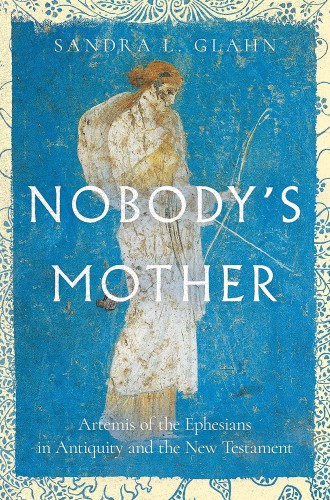An evangelical scholar reads scripture through Artemis
Sandra Glahn shows how the Greek goddess’s prestige influenced the portrayal of women in Ephesians and 1 Timothy.

Nobody’s Mother
Artemis of the Ephesians in Antiquity and the New Testament
Women without children, like me, may be disturbed by the assertion in 1 Timothy 2:15 that women will be “saved through childbearing.” Where does that leave us?
Sandra Glahn understands this concern personally. As she states in the introduction to Nobody’s Mother, she has had seven pregnancy losses, an ectopic pregnancy, and three failed adoptions. In this study, she dives deeply into the context of the first epistle to Timothy, with particular attention to the city of Ephesus and the Greek goddess Artemis, carefully dismantling the myth that Artemis was a fertility goddess.
Read our latest issue or browse back issues.
Glahn, who teaches at Dallas Theological Seminary, writes for an evangelical audience. She refers to Paul as the author of 1 Timothy (an attribution that many scholars would dispute) and spends some time justifying her role as a teacher despite being a woman. She states that Nobody’s Mother is for “the reader who wants to avoid sacrificing a high view of Scripture while working to reconcile conflicting narratives about God’s view of women.” Still, more progressive readers will glean much fascinating information from this tight, well-
researched book.
The meat of the argument about the “saved through childbearing” verse appears in the book’s final chapter. Before that, Glahn meticulously lays the groundwork. She begins by showing how most arguments against women in public ministry are historical rather than biblical. She ably demonstrates that the women’s movement is not responsible for women in ministry, showing that such ministry was embraced during Jesus’ time and in the earliest churches. She connects the later exclusion of women from ministry to a number of factors: the abandonment of the idea of a priesthood of all believers, the movement toward infant baptism (which eliminated the need for women to help female baptismal candidates get dressed), congregations moving from house churches to independent physical structures, and the influence of Greek cultural values on Christians.
Glahn spends the next four chapters writing about the city of Ephesus and the goddess Artemis, who is connected to Ephesus in Acts 19:23–41. The goddess’s enormous prestige in Ephesus significantly influenced the way women are portrayed in 1 Timothy and Ephesians—including the claim that women would be saved through childbearing. Some scholars regard Artemis as a fertility and mothering goddess, partly based on an ancient statue of Artemis that some believe shows her with many breasts. In a chapter about Artemis in architecture and art, Glahn posits that the items on this statue are jewelry instead of breasts. They are differently colored than the statue’s skin, they lack nipples and areolas, and they resemble items worn by male figures (including Zeus) in other statues.
In a chapter on Artemis in early literary sources, Glahn thoughtfully includes content warnings about sexual violence before sharing various myths about the goddess. Glahn concludes that evidence does not suggest that the Artemis cult was involved in prostitution but rather that she was a chaste virgin who was not associated with mothering (thus inspiring the book’s title). Artemis of Ephesus was associated with Amazon women in literature, as she was unmarried and carried a weapon. She was further associated with midwifery: one story tells of her being born before her twin brother and then helping their mother give birth to him. When 1 Timothy was written, giving birth was dangerous and life expectancies were short. Some Greek women prayed to Artemis to reduce their pain in childbirth.
Another chapter focuses on Artemis in epigraphic sources—that is, inscriptions. Glahn points out that such carvings are “unmediated primary sources from the past—no scribes have written comments in their margins or edited them.” She uses these underutilized sources to strengthen her argument that evidence does not suggest Artemis’s cult practiced prostitution or was anti-male. Further, the inscriptions do not suggest that she was a sex or fertility goddess.
The final chapter touches on various troubling instructions about women in 1 Timothy before focusing on the verse about childbearing. For example, the author writes about modesty, which has led some scholars to assume that religious pagans were obsessed with sex. In contrast, Glahn believes that the writer was speaking about social class rather than arguing against revealing clothing. Wealthy women could afford expensive coverings, fine jewelry, and elaborate hairstyles that showed their socioeconomic status. The letter writer envisioned Christianity as a religion without rank based on affluence, Glahn notes.
The troubling verse, 1 Timothy 2:15, states, “But women will be saved through childbearing—if they continue in faith, love and holiness with propriety” (NIV). Glahn believes that the writer here is attempting to counter the idea that praying to Artemis during childbirth will bring about a delivery without pain. Glahn further points out that the rest of the epistles emphasize salvation through grace by faith alone. Expecting all women to give birth in order to be saved contradicts other parts of scripture too, including 1 Corinthians 7:8, in which Paul suggests that widows should remain celibate. Glahn also suggests that the idea of women being saved through childbearing might refer not to eternal salvation but rather to “temporal deliverance. . . . What if the author was assuring Timothy that, in light of the nature of the local false deity, a woman in his pastoral care would not die in childbirth?”
Most mainline Protestants may not be as troubled as Glahn by the verse about childbearing. Nobody’s Mother might not be much help to mainline preachers—especially since many of our churches use the Revised Common Lectionary, which omits much of 1 Timothy, including the verse about childbearing. For women without children, however, this book sets that verse in its historical context and would make an excellent companion for Bible study.





